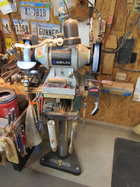So, I have a Wolverine grinding jig installed on my 8 inch grinder. I have two questions, one related to the installation and one related to the Vari-Grind accessories.
On my grinder I measure about 7 inches from the wheel center to the guide holders as opposed to the 6-1/4 to 6-1/2 mentioned in the instructions. Since this appears (from the instructions) to be a minimum will the extra height matter or should I put a half inch shim under the holders to raise them to the suggested distance?
Second question. I managed to successfully grind a bowl gouge (basically duplicated the factory grind) on a Robert Sorby 3/8 inch bowl gouge I bought used for practice - so far so good. I am thinking about being a bit more adventurous and trying the Vari-Grind attachment. Which of the two models available is preferable and why? Any and all information is appreciated. Thank you.
Barry W. Larson
Calgary, Alberta, Canada eh!
On my grinder I measure about 7 inches from the wheel center to the guide holders as opposed to the 6-1/4 to 6-1/2 mentioned in the instructions. Since this appears (from the instructions) to be a minimum will the extra height matter or should I put a half inch shim under the holders to raise them to the suggested distance?
Second question. I managed to successfully grind a bowl gouge (basically duplicated the factory grind) on a Robert Sorby 3/8 inch bowl gouge I bought used for practice - so far so good. I am thinking about being a bit more adventurous and trying the Vari-Grind attachment. Which of the two models available is preferable and why? Any and all information is appreciated. Thank you.
Barry W. Larson
Calgary, Alberta, Canada eh!

